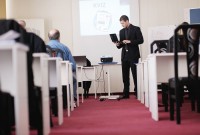- Home
- Business Processes
- Industry Knowledge
- Aerospace Industry
- Automotive Industry
- Banking Domain
- BFSI Industry
- Consumer/ FMCG Industry
- Chemicals Industry
- Engineering & Construction
- Energy Industry
- Education Domain
- Finance Domain
- Hospitality Domain
- Healthcare Industry
- Insurance Domain
- Retail Industry
- Travel and Tourism Domain
- Telecom Industry
- Leadership Skills
- eLearning
- Home
- Leadership
- Leadership Theories
- Contingency Theories in Action
Contingency Theories in Action
Contingency theory suggests matching the best leader to a specific situation based on situational factors and the leadership style. The practical application of theory can be done in various ways. The workplace example is to determine the best candidate for a given set of requirements using the LPC score. Applying the model to determine a leader's ability to adapt in the scenario of a new project etc..
Recap of Learnings from Contingency Theory:
Fielder’s contingency theory matches the leader to the situations by using the Least Preferred Co-Worker (LPC) model. A leader can perform effectively in certain roles and exhibit weakness in different situations based on three variables defined in the earlier article which predicts the favorability of the situation, while the leader’s LPC score determines the ability to function in the required task.
One can make use of the contingency theory to determine the best candidate for a given set of job requirements for effectiveness of a person in that role as by measuring a leader’s LPC score and the three situational variables, one can predict whether the leader is going to be effective in a particular setting. By assessing these three situational variables, one can place any organizational context in one of the eight categories represented in previous article. Once the nature of the situation is determined, the fit between the leader’s style and the situation can be evaluated.
Key Strengths of Contingency Theory:
1. Contingency theory is grounded in research as many researchers have tested it and found it to be a valid and reliable approach to explaining how effective leadership can be achieved.
2. This theory considers the impact of situations on leaders and focuses on the relationship between the leader’s style and the demands of various situations.
3. Third, contingency theory has predictive power and based on conclusions from LPC scale and understanding the context of the workplace situation one can determine the probability of success for a given person in a given situation.
4. From an organizational perspective it supports identification of optimal roles based on individual leadership styles and placing leaders in charge of situations that are ideal for their leadership style.
Practical Applications of the Theory:
Contingency theory has many applications in the organizational world:
1. Can be used to assess the effectiveness of an individual in a particular role and look at the reasons for one’s effectiveness or ineffectiveness.
2. Can be used to predict whether a person who has worked well in one position in an organization will be equally effective in another position having different situational variables when compared to the existing position based on the contingencies that make one’s style effective.
3. Can help in implementing changes in the roles and responsibilities that management might need to make to bring effectiveness to the role of the person leading the same.
Fiedler’s theory does not hold that leaders can adapt their styles to different situations as according to him personality is relatively stable. According to this model improving effectiveness involves changing the situation to fit the leader sometimes also referred to as “job engineering”.
As now we have more understanding of leadership and its challenges in the 21st century organizational context, contingency model might not be the best leadership model to use in most situations, but still can be a powerful tool to analyze a particular situation to determine whether to focus on tasks or relationships. This model sometimes can give an inaccurate picture of your leadership style as it relies heavily on the LPC scale, which has been questioned for its face validity and workability. Further this model does not fully explain how organizations can use the results of this theory in situational engineering and hence we recommend taking a cautious approach and using your own judgment to analyze the situation from all angles.
Related Links
You May Also Like
-
Investment Theory of Creativity
Sternberg in the year 2006, proposed the investment and confluence theory focused on understanding creativity. According to the investment theory, creativity requires a confluence of six distinct but interrelated resources known as intellectual abilities, knowledge, styles of thinking, personality, motivation, and environment. It emphasizes that creativity is not about one thing, but about a system of things.
-
Attribution Theory of Leadership
The attribution theory of leadership deals with the formation of individual opinions about the reasons for particular events or observations. People will always try to understand why people do what they do. The leader will make a judgment about his employees based on his attribution of the causes of the employees' performance. Individuals will also make inferences about the leader and react to poor performance by the leader.
-
Lewin’s Change Management Model
Lewin's change management model is a framework for managing organizational change. Lewin's methodology of different Leadership Styles recognizes three distinct stages of change - creating the perception; moving toward the new desired level of behavior and, ensuring new behavior as the norm.
-
Leader-Participation Model provides a set of rules to determine the form and amount of participative decision making. It helps identifies different ways a decision can be made based on the degree of follower participation. It proposes a method for leaders to involve all members of the organization work together to make decisions.
-
Burns Transformational Leadership Theory
Transformational leadership theory has been defined by James MacGregor Burns as a process where both leaders and followers mutually raise one another to higher levels of morality and motivation. The concept of transforming leader works with teams to garner trust, respect, and admiration while reaching to higher moral positions. The transformational theory of leadership was developed while studying political leaders and how they use charismatic methods to attract people to the values.
-
Team leadership theory is a recent leadership theory that does not discriminate between the leader and the other team members. The approach considers contributions from each team member to be critical for organizational success. This approach focused on the overall team effectiveness and team problems are diagnosed and action is taken to remediate weakness. This approach provides for taking corrective action when the leader deems necessary.
-
Rensis Likert studied the patterns and styles of managers and developed four management systems known as Likert's management systems. These styles developed by him are known as Likert management systems. System 1 - Exploitative Authoritative; System 2 - Benevolent Authoritative; System 3 - Consultative and System 4 - Participative.
-
McClelland's Theory of Needs is a human motivation theory which states that an individual's specific needs are acquired over time through our culture and life experiences. As per the three needs theory, these acquired needs significantly influence the behavior of an individual. The three main driving motivators are the needs for achievement, affiliation, and power.
-
Functional leadership theory addresses specific leader behaviors that are expected to contribute most to the organizational effectiveness by focusing on how the leadership process occurs. The leader should ensure that all needs of the group get addressed.
-
Blake and Mouton Managerial Grid is a style leadership model that identified five manager styles based on two dimensions viz concern for people and the concern for production. Managerial Grid uses concern for production style which is largely based on McGregor's Theory X.
Explore Our Free Training Articles or
Sign Up to Start With Our eLearning Courses

About Us
Learning
© 2023 TechnoFunc, All Rights Reserved









